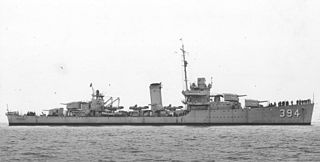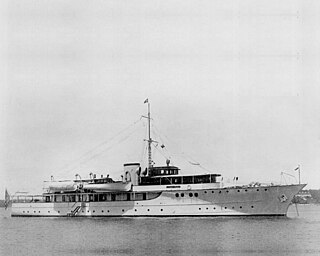
USS S-26 (SS-131) was an S-class submarine of the United States Navy. She was lost in a collision with a friendly escort ship in late January 1942.

USS Impetuous (PYc-46) was a private yacht purchased by the Navy in August 1940 that served as a patrol boat of the United States Navy in Central America. The yacht was built as Paragon, the first of at least two Davol yachts to bear the name, in 1915 for Charles J. Davol of Providence, Rhode Island. In 1916 Davol sold the yacht to John Fred Betz, 3d of Philadelphia who renamed the yacht Sybilla III which served as the Section Patrol yacht USS Sybilla III (SP-104) from May 1917 to December 1918. Sybilla III remained in Betz's ownership until sale in 1935 to R. Livingston Sullivan of Philadelphia who renamed the yacht Arlis. On 12 August 1940 the Navy purchased the yacht placing it in commission as USS PC-454 on 16 October. The vessel was given the name Impetuous and reclassified PYc-46 on 15 July 1943. The yacht was decommissioned at Philadelphia 31 August 1944 and transferred to the War Shipping Administration for sale.
The second USS Sapphire (PYc-2) was a patrol boat in the United States Navy.
USS Amethyst (PYc-3) was the yacht Samona II taken into service in the United States Navy serving as a patrol boat during World War II. After military service the vessel was returned to civilian status in 1946 and again became the yacht Samona II until sale and subsequent names of Pudlo and Explorer.

USS Onyx (PYc-5), was a diesel coastal patrol yacht of the United States Navy during World War II.

USS Warrington (DD-383) was a Somers-class destroyer, laid down on 10 October 1935 at Kearny, New Jersey, by the Federal Shipbuilding and Drydock Company; launched on 15 May 1937; sponsored by Miss Katherine Taft Chubb; and commissioned at the New York Navy Yard on 9 February 1938.

The second USS Sampson (DD-394) was a Somers-class destroyer in the United States Navy. She was named of William Thomas Sampson a rear admiral known for his victory in the Battle of Santiago de Cuba during the Spanish–American War.
USS Patriot (PYc-47), formerly the Katoura, was built in 1930 by the Herreshoff Manufacturing Company in Bristol, Rhode Island United States and purchased by the United States Navy, for $1.00, from Mr. A. Loomis of New York City on 20 September 1940. She was converted for Navy service as a submarine chaser at the Greenport Basin and Construction Company at Greenport, New York, and designated PC–455 on 4 November 1940. She was placed in service 27 February 1941.
The first USS Persistent (PYc-48) was a submarine chaser of the United States Navy.

USS Moonstone (PYc-9) was a coastal patrol yacht in the service of the United States Navy. She was built in 1929 as Nancy Baker by Germaniawerft in Kiel, Germany, later renamed Mona, and subsequently acquired by the Navy as the Lone Star on 10 February 1941. Renamed Moonstone and designated PYc-9, she was converted for U.S. Navy service in Jacksonville, Florida, and commissioned on 10 April 1941. She was named for the gemstone moonstone.
USS Johnnie Hutchins (DE-360) was a John C. Butler-class destroyer escort acquired by the U.S. Navy during World War II. The primary purpose of the destroyer escort was to escort and protect ships in convoy, in addition to other tasks as assigned, such as patrol or radar picket. She served in the Pacific Ocean, and, post-war, she returned home with a Navy Unit Commendation awarded to her for her battle with Japanese midget submarines on 9 August 1945.
USS Albatross (AMS-1/YMS-80) was an YMS-1-class auxiliary motor minesweeper acquired by the U.S. Navy during World War II for clearing coastal minefields.

USS Goldcrest (AM-78) was a minesweeper acquired by the U.S. Navy for the dangerous task of removing mines from minefields laid in the water to prevent ships from passing.
USS Venture (PC-826/PYc-51) was a patrol boat acquired by the U.S. Navy for the task of patrolling the coastal waters of the New York coast during World War II. Her primary task was to guard the coastal area against German submarines. For this reason, she carried depth charges.

USS PGM-18 was a PGM-9-class motor gunboat built for the United States Navy during World War II. She was built and originally commissioned as USS PC-1255, a PC-461-class submarine chaser, and was decommissioned and converted in late 1944. USS PGM-18 struck a mine off the coast of Okinawa in April 1945; 13 men lost their lives when PGM-18 sank.
USS Sardonyx (PYc-12), formerly the yacht named Queen Anne (1928), was a patrol boat in the United States Navy during World War II.

The USS Alabaster (PYc-21) was a coastal patrol yacht of the United States Navy during World War II.

USS Valiant (PYc-51), originally USS PC-509, was a United States Navy patrol vessel in commission from 1941 to 1944.

USS Phenakite (PYc-25) was a converted yacht that was used by the United States Navy during World War I and World War II. The vessel was also known as Celt, Sachem (SP-192), Sightseer and Circle Line V.
USS Topaz (PYc-10) was a coastal patrol yacht in the service of the United States Navy. She was named for the gemstone Topaz.











